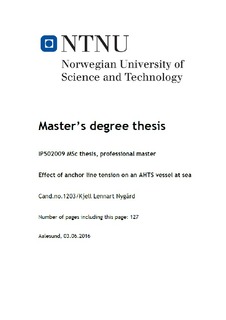| dc.contributor.advisor | Halse, Karl Henning | |
| dc.contributor.author | Nygård, Kjell Lennart | |
| dc.date.accessioned | 2016-10-26T11:41:03Z | |
| dc.date.available | 2016-10-26T11:41:03Z | |
| dc.date.issued | 2016 | |
| dc.identifier.uri | http://hdl.handle.net/11250/2417776 | |
| dc.description.abstract | In this thesis, the aim was to simulate a typical anchor-handling situation in order to study the influence from an anchor line. With today's computer power and simulation programs simulations be performed at reasonable cost, and many different scenarios may be studied without any safety issues. The roll response due to waves in the simulator was on forehand compared with RAO from ShipX and found to comply well for different wave periods. The simulation results is compared with stability calculations and the roll motion in the simulations was found to comply well with this calculations. | nb_NO |
| dc.description.abstract | Main problems: Due to limied time, it was agreed not to include forces from drag, inertia or line stiffness in the anchor line model. Especially in deep water, operations the drag caused by strong ocean currents is assumed to have considerable influence on the results. Tuning of the propulsion forces to keep the vessel at position has influence on the results, and it was needed to find reasonable values for the controller gain without overcompensating. | nb_NO |
| dc.description.abstract | Main results: In the critical anchor handling situation the weight of anchor line possible to handle had to be reduced with more than 50% compared with results from the stability calculations. From the simulations, it was concluded that the anchor line is increasing the response amplitude operator for roll, because the propulsion is creating moments while keeping the vessel in position and stable heading. It was also found that moving the line sideways on the vessel stern has significant influence on the roll amplitudes in addition to increased heel angle. | nb_NO |
| dc.description.abstract | Main conclusion: The main conclusion is that the load from the anchor line is affecting the limits for safe operation by influencing on the heel and the roll amplitudes. The heel from 20-sim simulations was found to comply well with the stability calculations performed in MaxSurf. In this thesis, the results must be read as simplifications, but still it may point out some critical moments. | nb_NO |
| dc.language.iso | eng | nb_NO |
| dc.rights | Navngivelse-Ikkekommersiell-IngenBearbeidelse 3.0 Norge | * |
| dc.rights.uri | http://creativecommons.org/licenses/by-nc-nd/3.0/no/ | * |
| dc.subject | Anchor handling | nb_NO |
| dc.subject | Vessel | nb_NO |
| dc.title | Effect of anchor line tension on an AHTS vessel at sea | nb_NO |
| dc.type | Master thesis | nb_NO |
| dc.subject.nsi | VDP::Technology: 500::Marine technology: 580::Ship technology: 582 | nb_NO |
| dc.source.pagenumber | 127 | nb_NO |

